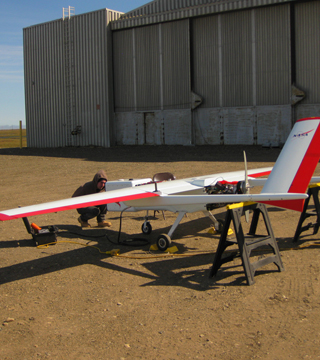
The Sierra went down over the Arctic Ocean on the morning of July 26, about 60 miles from the northernmost tip of North America. One moment the unmanned aerial vehicle (UAV) with its 20-foot wingspan was up in the sky, gathering “hard” data over frozen terrain to help climate simulators in comfortable offices make predictions about climate change. The next moment, the little aircraft was gone.
“Just as I walked into the ground control station,” says Darin Desilets (6913), “a gentleman from NASA was calling in to air traffic controllers in Deadhorse [a nearby settlement], ‘Flight terminated.’”
The ground control station is at Oliktok Point, the northernmost point of oil-rich Prudhoe Bay on Alaska’s North Slope. The station consists of
a series of well-insulated but otherwise commonplace trailers from the 1950s that provide living quarters for researchers. The site’s other feature is an aging hangar in which UAVs can be housed, along with land-based monitoring equipment being assembled to detect features like cloud height, incoming and outgoing radiation, and other factors of climatological interest. The facility, owned by the Air Force, is used by Sandia for DOE’s Atmospheric Radiation Measurement (ARM) program, and provides a launching point to restricted air space for scientific experiments.
‘Try doing our work somewhere else’
“Climate simulators don’t think about how difficult it is to get the data their supercomputers use,” says Darin, “but they need that data to develop or even validate how the climate system works.”
Oliktok Point, as inaccessible as it is, has the infrastructure to support the frigid research. Oil companies that lease the peninsula require visitors to be badged to use the roads and have limited interest in supporting climate research, but their strong financial presence means forklifts and other equipment can be leased in Deadhorse and there’s an airport on the Arctic Ocean with several flights a day. “Try doing our work somewhere else,” Darin says.
The Sierra’s mission was focused on monitoring something called “the sea/ice margin,” the point at which the solid ice of the frozen north thaws into open sea. This line moves with the seasons and changes each year.
“This event underscores just why unmanned aircraft are so important in the Arctic,” says Darin. “The big deal would be to have a manned aircraft go down on the ice or, worse, in that almost 0 degree C water.”
Another aircraft flew over the crash site’s presumed coordinates two days later and saw open water with some ice chunks, indicating the disabled aircraft had probably sunk.
Says Sandia project lead Mark Ivey (6913), “In talking with our team members who were at Oliktok after the loss of Sierra, they said the NASA team took the loss in stride. Losing an unmanned aerial system (UAS) is a calculated risk, a risk that goes up in the Arctic. They are talking seriously about returning with a new UAS next year or the year after.” Mark negotiated user agreement hurdles for NASA’s experiments to be run at the site.
Sierra is an acronym for Sensor Integrated Environmental Remote Research Aircraft. The small machine was designed by the US Naval Research Laboratory and developed at NASA’s Ames Research Center in Moffett Field, Calif., to perform remote sensing and atmospheric sampling in isolated and often inaccessible regions. It did not require a large runway. Among the achievements that could be inscribed on its watery tombstone, it was the first civilian UAV to be allowed use of ground radar for sensing and avoidance, and the first to be granted a reserved altitude to fly safely from restricted to open air space. “Synchronizing with these FAA (Federal Aviation Administration) procedures should make it easier to fly UAVs from Oliktok in the future,” says NASA project manager Matt Fladeland.
Two other UAVs flew successful missions for several weeks with operations concluding on Aug. 9.
Sandia personnel who monitor the barren, windswept site in six-week sessions keep equipment running, help translate flight plans into NOTAMS (Notices to Airmen), ensure correct information is broadcast about activation or deactivation of the restricted area, and help resolve potential conflicts with local aviation concerns over airspace use.
Polar bears provide strong reasons to ignore any impulse to jog, says Jerry Peace (2127), another member of the Sandia Oliktok team.
As the poet John Milton put it, “They also serve who only stand and wait.”
* * *
Climate measurement strategy at Oliktok Point has three basic aspects, according to Fred Helsel (6913), Sandia’s Oliktok team leader:
- • Extensive airborne surface mapping, repeated frequently over sufficiently large areas, to accommodate comparisons with satellite-derived sea surface temperature and sea ice data sets.
- • Sustained, continuous observations of ocean surface, subsurface, and atmospheric conditions over tens of hours, sufficient to investigate sea・]ice/atmosphere interactions and obtained at spatial scales orders of magnitude finer than provided by satellites.
- • Repeated visitation to locations within the drifting ice pack, allowing tracking and observations over a period of weeks to assess how specific portions of the ice pack evolve over the summer.